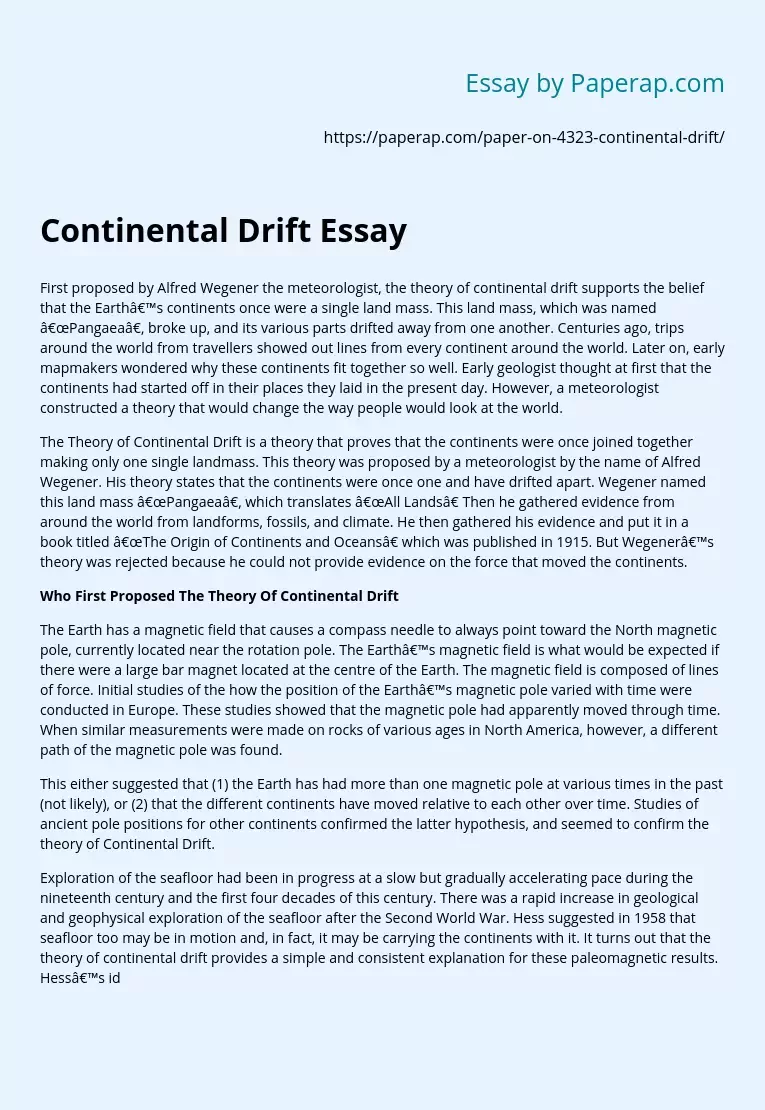Continental Drift Essay
First proposed by Alfred Wegener the meteorologist, the theory of continental drift supports the belief that the Earth’s continents once were a single land mass. This land mass, which was named “Pangaea”, broke up, and its various parts drifted away from one another. Centuries ago, trips around the world from travellers showed out lines from every continent around the world. Later on, early mapmakers wondered why these continents fit together so well. Early geologist thought at first that the continents had started off in their places they laid in the present day.
However, a meteorologist constructed a theory that would change the way people would look at the world.
The Theory of Continental Drift is a theory that proves that the continents were once joined together making only one single landmass. This theory was proposed by a meteorologist by the name of Alfred Wegener. His theory states that the continents were once one and have drifted apart. Wegener named this land mass “Pangaea”, which translates “All Lands” Then he gathered evidence from around the world from landforms, fossils, and climate.
He then gathered his evidence and put it in a book titled “The Origin of Continents and Oceans” which was published in 1915. But Wegener’s theory was rejected because he could not provide evidence on the force that moved the continents.
Who First Proposed The Theory Of Continental Drift
The Earth has a magnetic field that causes a compass needle to always point toward the North magnetic pole, currently located near the rotation pole.
The Earth’s magnetic field is what would be expected if there were a large bar magnet located at the centre of the Earth. The magnetic field is composed of lines of force. Initial studies of the how the position of the Earth’s magnetic pole varied with time were conducted in Europe. These studies showed that the magnetic pole had apparently moved through time. When similar measurements were made on rocks of various ages in North America, however, a different path of the magnetic pole was found.
This either suggested that (1) the Earth has had more than one magnetic pole at various times in the past (not likely), or (2) that the different continents have moved relative to each other over time. Studies of ancient pole positions for other continents confirmed the latter hypothesis, and seemed to confirm the theory of Continental Drift.
Exploration of the seafloor had been in progress at a slow but gradually accelerating pace during the nineteenth century and the first four decades of this century. There was a rapid increase in geological and geophysical exploration of the seafloor after the Second World War. Hess suggested in 1958 that seafloor too may be in motion and, in fact, it may be carrying the continents with it. It turns out that the theory of continental drift provides a simple and consistent explanation for these paleomagnetic results. Hess’s idea explained neatly why the drifting continents did not leave any scars on the seafloor. It also shifted the spotlight from the mechanism of continental drift that had bothered Wegener greatly. In time, Hess’s geopoetry became known as the seafloor spreading hypothesis.
A fossil is any evidence of ancient life. In the beginning of the 20th Century, fossil evidence was also found to support continental drift. Identical fossilized plant and animal species have been found in many different places, on different continents. It seems hard to believe that such similar organisms would exist so far away from each other, or that they could have swam from one continent to another. It is more likely that these life forms once lived all together on a single continent, as shown in the following image. An example of this would be that in places like South America and Africa the same animal fossils have been found which could only have happened if they were originally joined.
Palaeoclimatology is the study of changes in climate taken on the scale of the entire history of Earth. Parts of all the continents in the Southern Hemisphere were covered by glaciers in their geological past. Glaciers grind and smooth the rocks across which they move, and leave grooves where rocks that were caught in the ice grated over the bottom rocks. When the ancient scour marks on the continents in the Southern Hemisphere are studied, it appears as if the ancient glaciers were formed in the oceans and moved towards the land. But no glacier we know of functions in this way. Glaciers usually form in high-lying regions and then move slowly downwards in the direction of the oceans. However, if we could move the continents back to recreate Gondwana, all ancient glacier parts would fit neatly into one another without being separated by oceans.
Continental Drift Essay. (2019, Dec 05). Retrieved from https://paperap.com/paper-on-4323-continental-drift/

